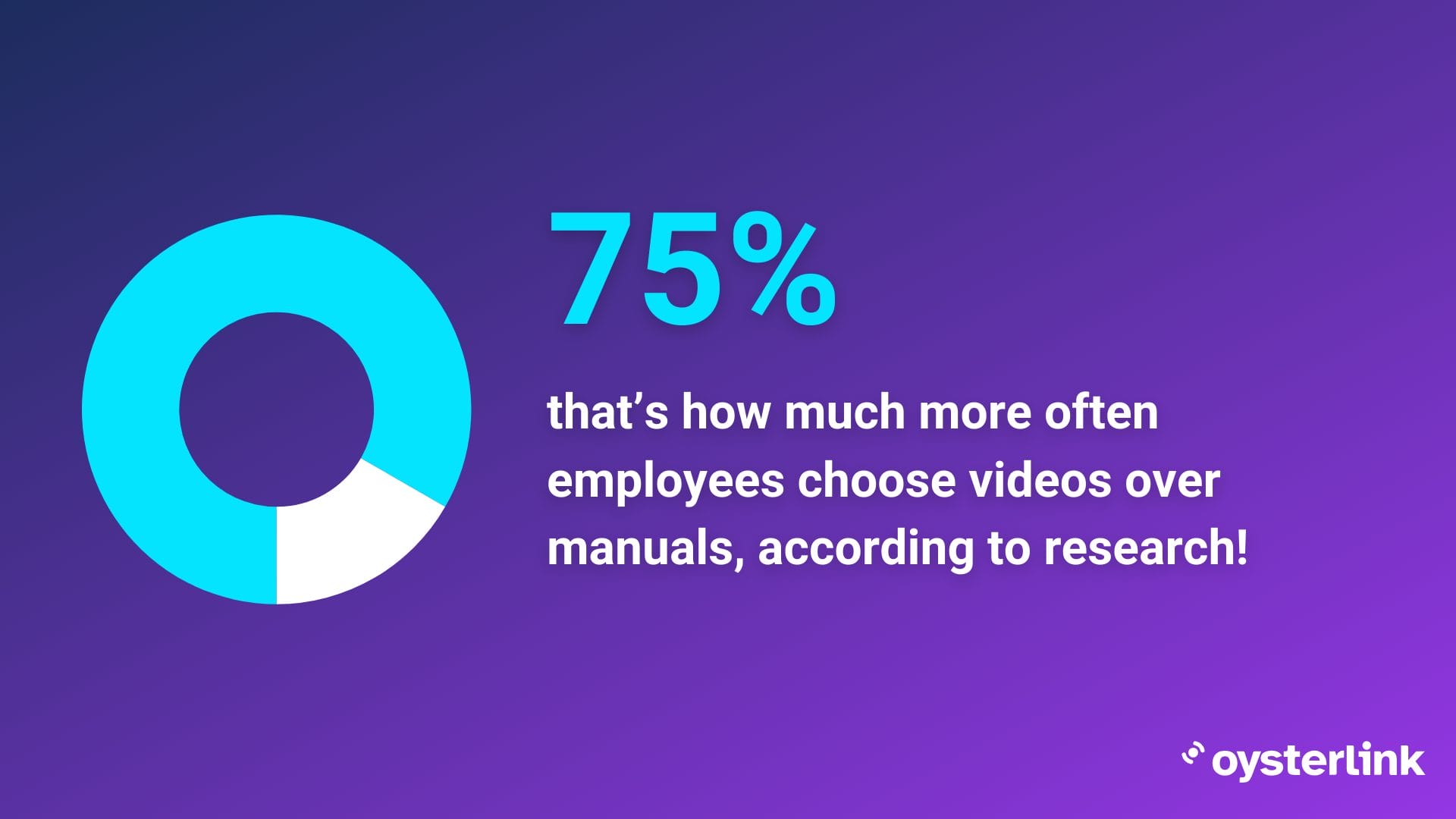Restaurant staff turnover is a big challenge, with rates reaching 75% each year and new hires costing an average of $1,070. Despite this, many restaurants still rely on outdated methods like traditional employee handbooks — used by 70% of establishments — rather than adopting modern, engaging approaches such as restaurant training videos.
Video-based learning offers a dynamic way to reduce turnover and cut down on training costs. Not to mention, it clicks with most people, as research shows that visual learners make up 65% of the population. That said, now is the perfect time to update your training approach (if you haven’t yet).
This guide explores how to create effective restaurant training videos, including tips, tools and strategies to boost your team’s performance.
Understanding Video Training ROI
Measuring the return on investment (ROI) of your restaurant training videos requires understanding key performance metrics. Research shows that employees watch video content 75% more often than they read documents or manuals.
Measuring staff performance improvements
With your video training platform, you can easily track employee progress and engagement levels.
Monitor completion rates, quiz scores and time spent on each module to identify areas where your staff might need extra support. Plus, tracking metrics like video views helps you see which content resonates most with your team, so you can create even better training materials moving forward.
Looking at the numbers before and after video training really shows the difference. Employees who finish detailed training programs boost customer satisfaction by up to 7%, which says a lot about how well it works!
Tracking knowledge retention rates
Video training makes a big difference in how well people remember information.
Research proves that learning retention rates jump from just 5% with traditional lectures to 20% with video-based training. In fact, the brain processes video content 60,000 times faster than text, which makes it a very quick way to learn.
[Source: The Peak Performance Center]
Calculating cost savings vs. traditional training
Video training saves money compared to old-school methods. These are the main financial benefits:
- No printed materials and instructor fees
- Less travel expenses for trainers
- No venue rental costs for training sessions
- Less time needed for training
It’s well-documented that transitioning to video-based training can lead to significant cost savings.
For example, companies with 10,000 or more employees spend approximately $924 per employee on training, while those with 1,000-9,999 employees spend about $581 per employee.
Creating Role-Specific Training Videos
Restaurant staff members watch training videos 75% more often than they read manuals. It’s no surprise — videos are quicker, easier and more engaging. That’s why video content has become essential for modern restaurant training.

The trick is to make it targeted: Create role-specific videos that speak directly to the needs of each role. Pair these with hands-on practice and you’ve got a recipe for a well-trained team.
Front-of-house training modules
Those in front-of-staff such as Servers and Hosts/Hostesses need detailed training modules that focus on guest interaction and service standards. As such, your videos must show proper greeting procedures, table service techniques and POS system operations.
The content also has to teach staff how to handle difficult situations and stay professional during rush hours.
Overall, front-of-house staff training should target these vital areas:
- Guest interaction and hospitality standards
- Table service techniques and etiquette
- POS system operation and order management
- Upselling strategies and menu knowledge
Kitchen staff and food safety videos
Busy restaurant kitchens need safety training videos to prevent accidents. As a result, your training must cover these five core areas of commercial kitchen operations:
- Line Cook station safety
- Food preparation protocols
- Walk-in refrigerator procedures
- Speeding up station management
- Dishwashing safety standards
Kitchen staff need detailed food safety modules. Your videos should demonstrate proper food handling, sanitization techniques and temperature monitoring protocols.
See also: Restaurant Kitchen Fire Safety: Prevention, Recovery & Essential Tips
Management training content
Creating effective management training content is key to helping leaders succeed and guide their teams with confidence. Here are some essential topics to include:
| Skills To Develop | Key Focus Areas |
|---|---|
| Emotional intelligence (EQ) | Equip Managers with skills to build better relationships through self-awareness, empathy, and strong communication. |
| Communication | Teach techniques for presenting ideas clearly, listening actively, and connecting with diverse personalities. |
| Time management | Help Managers prioritize tasks and organize their day for maximum productivity. |
| Conflict resolution | Show them how to handle workplace disagreements professionally and create a positive work environment. |
| Adapting to change | Prepare leaders to guide their teams through transitions with confidence and clear strategies. |
| Smart decision making | Strengthen their ability to analyze situations and make thoughtful, effective choices. |
| Team building | Foster skills that encourage collaboration and create strong, motivated teams. |
By covering these areas, your training program will empower managers to lead successfully, adapt to challenges and inspire their teams to achieve great results.
See also: Best Practices in Restaurant Operations Management
How To Implement a Video Training Program for Your Restaurant
A well-laid-out video training program just needs proper planning and systematic execution. Studies reveal that 94% of workers would stay longer with companies investing in employees’ development.
Set up your training schedule
The training schedule works as your implementation roadmap. That said, create a structured timeline that has both original training and ongoing development modules.
Your schedule should adapt to different learning speeds because digital training lets employees access materials whenever they want.
These core components belong in your training calendar:
- Initial onboarding videos and assessments
- Weekly skill development modules
- Monthly performance review sessions
- Quarterly refresher courses
Combine videos with hands-on training
Results improve when you mix hands-on practice with video content. Studies show that 38% of restaurant employees have already involved themselves in online training. This makes it vital to balance digital learning with practical experience.
Video training works best alongside hands-on practice sessions. Servers can participate in role-playing exercises after watching customer service videos. For example, Line Cooks can practice food preparation techniques right after they view relevant instructional content.
Provide progress tracking systems
Modern learning management systems provide strong tracking features to monitor your staff’s growth. These platforms give you live analytics about course completion rates and knowledge retention.
The system helps identify skills gaps and spot high-potential candidates for promotion. Things like daily quiz results and video completion rates can tell you if your team stays current with training requirements.
Tips for Maximizing Training Video Effectiveness
Below are a few essential tips to help ensure your restaurant training videos are engaging, effective and relevant for your staff.
Address different learning styles
Your kitchen and service staff fall into three main learning groups:
- Visual learners: They learn best through watching demonstrations.
- Auditory learners: They remember 75% of what they hear.
- Hands-on learners: They need to practice while they learn.
Mix these approaches in your videos. Good training combines clear visuals, strong voice-overs and practice opportunities. This helps every staff member master new skills, whether they’re visual, auditory, or hands-on learners.
Include interactive elements and assessments
Interactive training videos beat passive watching every time. Quick quizzes, team polls and real-world scenarios keep your staff engaged and help them remember what they learn.
Your training platform should show you who’s engaging and who needs help. Watch these numbers closely — they tell you which topics need more attention and which staff members could use extra support.
Update video content regularly
Keep your videos fresh with current menu items, service standards and safety rules. Regular updates are key to ensuring your training stays relevant. Highlight new dishes, emphasize changes in protocols and refresh safety reminders to keep your team informed.
Outdated videos can lead to confusion, so staying current is non-negotiable.
Also, consider building a collection of staff-favorite training videos to encourage engagement. Include tips and tricks from seasoned team members, fun behind-the-scenes insights or troubleshooting solutions for common challenges. Featuring staff contributions can make the library more relatable and enjoyable.
Just remember — videos support hands-on training, they don’t replace it.
Conclusion
Restaurant training videos work — the numbers prove it. Staff remember 75% of what they learn through video compared to just 5% from traditional manuals. V
ideo training delivers real results when done right. Your front-of-house and kitchen staff learn faster by watching demonstrations followed by hands-on practice.
Role-specific videos plus progress tracking keep your service standards high across every shift.
All in all, the secret to great video training is simple: All you need are fresh content and smart implementation. Match your videos to how your staff learns best, track the results and watch your team grow.
Restaurant Training Videos FAQs
Restaurant training videos improve staff performance by increasing knowledge retention rates from 5% to 75%, reducing training costs and standardizing the training process across different shifts and locations.
Managers can measure video training effectiveness by tracking staff performance improvements, monitoring completion rates and quiz scores and calculating cost savings compared to traditional training methods.
Restaurants should create role-specific videos for FOH employees (covering guest interaction and service standards), kitchen staff (focusing on food safety and kitchen operations) and management (addressing leadership skills and operational excellence).
To implement a successful video training program, you should set up a training schedule, combine videos with hands-on practice and use progress tracking systems to monitor staff development and identify gaps.
To maximize video training effectiveness, you should address different learning styles, incorporate interactive elements and regularly update content to keep it current with menu changes and service standards.

Written by Lidija Misic
Lidija holds a BA in English Language and has lived in five different countries, where she has worked in various roles, including as a flight attendant, teacher, writer and recruiter. Her biggest passion is crafting great content and reading. She is particularly passionate about creating punchy copy that inspires people to make positive changes in their lives.

Reviewed by Marcy Miniano
Marcy is an editor and writer with a background in public relations and brand marketing. Throughout her nearly decade-long career, she has honed her skills in crafting content and helping build brands across various industries — including restaurant and hospitality, travel, tech, fashion and entertainment.




